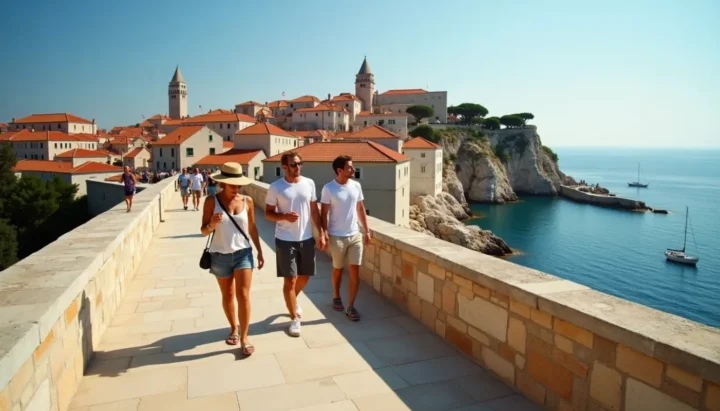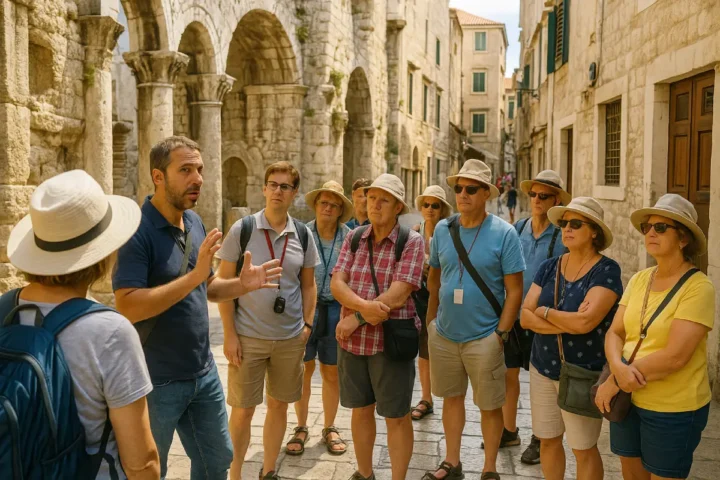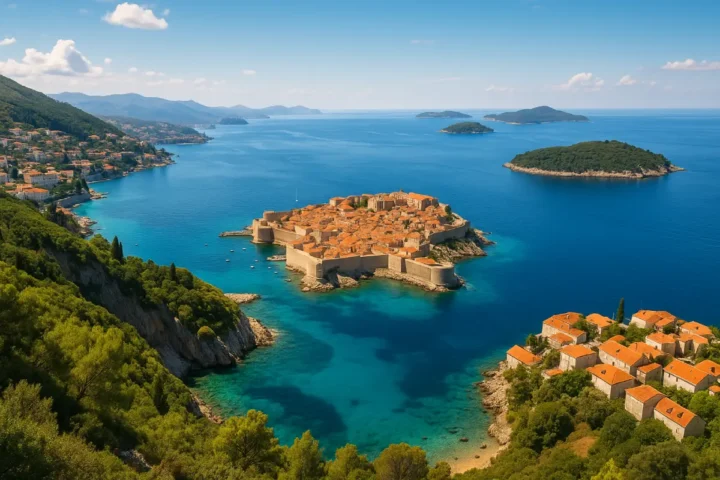Is Croatia Safe to Visit for Tourists?
Many people are asking is Croatia safe to visit? Croatia ranks 15th out of 163 countries worldwide in the 2024 Global Peace Index, making it one of the most peaceful nations globally. Many travelers planning European getaways wonder about Croatia’s safety, especially when they have plans to visit its stunning Adriatic coastline and historic cities. The data shows Croatia maintains one of the lowest crime rates in Europe.
The US State Department has given Croatia its highest safety rating as a Level 1 destination, which means visitors need only take normal precautions. A 2025 survey of 40 European countries revealed Croatia as the safest place to walk after dark. The country experiences rare instances of violent crime compared to many other destinations.

Travelers can safely stay in Croatia for extended periods, though they should learn about local customs and simple safety practices. American tourists face minimal safety concerns according to the State Department’s advisory. Research about cost of living in Croatia and weed laws will help visitors better understand local regulations and expenses.
How safe is Croatia for tourists?
People often ask about Croatia’s safety compared to other European hotspots. Let’s get into the numbers that show why safety-conscious travelers keep choosing Croatia.
Croatia’s Global Peace Index ranking
Croatia stands as the world’s 19th safest country based on the 2025 Global Peace Index, which looks at 163 nations. The country dropped slightly from its 15th spot in 2024, but remains among the 20 most peaceful countries worldwide. The country’s safety ratings beat several bigger, more developed nations.
The Global Peace Index looks at 23 indicators in three main areas:
- Societal safety and security
- Ongoing domestic and international conflict
- Militarization
Croatia’s high safety status stands out even more as global peace levels continue to drop. While Croatia stays stable, North America shows the biggest drop in regional peace due to rising violent crime.
Should tourists feel safe in Croatia based on these rankings? Yes, it is safe. Croatia ranks as Europe’s 11th most peaceful country, ahead of Germany, Italy, the United Kingdom, and France.
US State Department travel advisory
The US government gives Croatia its lowest travel advisory – Level 1, which means “exercise normal precautions”. This rating came out in August 2024 and reflects Croatia’s current situation.
The State Department points out that “violent crime is rare” in Croatia. Notwithstanding that, they mention that “isolated attacks targeting specific persons or property can occur and may be racially motivated or prompted by lingering ethnic tensions from Croatia’s war for independence”.
Croatia’s safety level matches up well against other destinations. Its Level 1 status puts it among the safest places for American travelers. Canadian and Australian governments also rate Croatia at their lowest risk level.
Pickpocketing can happen in busy tourist spots. Police stay visible and respond quickly in popular tourist areas.
Is Croatia safe for American tourists?
Americans face no specific threats in Croatia. Strong ties between Croatia and the US create a friendly atmosphere for American visitors.
English speakers will feel at home since many Croatians in tourist areas speak English. This makes it easy to get around or find help when needed. Healthcare in major cities meets high standards, though rural areas might have fewer options.
Adventure seekers can feel safe in Croatia, but should take basic precautions. The armed conflict ended in 1995, but some old minefields exist near former battle areas, which have clear markings. Stick to marked trails when hiking, especially in rural parts.
Smart travelers should know Croatia’s living costs to plan their budget better. Learning about local laws helps avoid any trouble during your stay.
Croatia proves itself as one of Europe’s safest spots. Low crime rates, stable politics, and strong safety rankings make it a great choice for travelers from any country.

Common crimes and how to avoid them
Croatia ranks among Europe’s safest destinations, but smart travelers should know about some common crimes. I’ve been to every corner of this beautiful country and can tell you that Croatia is safe, but knowing what to look out for will improve your trip.
Pickpocketing in tourist areas
Petty theft, mainly pickpocketing, is the most common crime tourists face in Croatia. Tourist spots like Dubrovnik’s Old Town, Split’s Diocletian’s Palace, and Zagreb’s busy areas have higher risks. Pickpocketing isn’t as common here as in other European cities, but staying alert matters.
Note that you should keep your belongings close, especially when you have crowds, bus and train stations, public transport, and beaches around. Zagreb shows higher petty crime rates than other Croatian cities. So, stay extra careful near Zagreb Bus Terminal, and don’t go to Ribnjak Park and King Tomislav Square after dark.
Don’t carry more than €240 (approximately $250) at once. Put your valuables in hotel safes whenever you can. On top of that, anti-theft accessories like slash-resistant bags help when you’re in busy areas.
Taxi scams and how to avoid overcharging
Are taxis safe in Croatia? Usually yes, but some drivers might overcharge tourists, especially from airports or nightspots. To skip taxi scams:
- Get the price before you get in
- Make sure the meter starts running when your trip begins
- Use taxi apps like Uber or Bolt that show prices upfront
- Skip taxis waiting right at bus/train station entrances
- Pick well-marked taxis with clear logos and phone numbers
Watch out when drivers offer help with luggage – some use this to distract you. Most taxi drivers in Croatia are honest, but being prepared helps you avoid the few bad ones.
ATM and currency exchange tips
Banking safely is vital if you’re traveling to Croatia on a budget. Tourists sometimes face ATM skimming and currency exchange scams. Stick to ATMs at official Croatian banks instead of standalone “ATM” machines in tourist spots.
Look carefully at the card slot for anything odd when using ATMs. Hide your PIN as you type it, even in places that seem safe. Always say no to “dynamic currency conversion” offers for withdrawing in your home currency—pick the local currency (Euro) instead.
Tourist area exchange booths often advertise great rates but hide extra fees. One case showed tourists getting only 610 kuna for €100 when they should’ve received about 730-740 kuna.
Avoiding ‘gentlemen’s club’ scams
The costliest scams happen at ‘gentlemen’s clubs’ in coastal areas. These places have charged tourists thousands of euros and used security guards to scare people who won’t pay.
One case showed tourists being charged 12,000 kuna (about $2,000) for drinks they never ordered. The UK Foreign Office warns British citizens specifically about these places.
American tourists exploring Croatia’s nightlife are usually safe if they stay away from these clubs. If you visit bars or clubs, check prices first, watch your drink, and ask for itemized bills for everything you buy.
Croatia’s cost of living stays affordable, so regular nightlife won’t break the bank. If a price looks wrong, it probably is. Learning about local laws will help you stay out of trouble during your visit.
Is it safe to travel around Croatia?
Questions about transport safety often come up when people travel through Croatia’s varied landscapes. Getting around becomes easy once you know your options. Let’s see how safe it is to move between Croatia’s beautiful destinations.
Driving safety and road conditions
Driving in Croatia is mostly straightforward and safe. The major roads and highways are in good shape with signs in both Croatian and English. Road conditions change by a lot across the country, though you’ll find it’s generally safe to drive.
Modern multilane motorways that connect north to south give drivers a smooth experience. The coastal roads tell a different story – they’re narrow, winding, and can get slippery in wet weather. Rural areas and islands bring more challenges since the roads are narrower and some don’t have guardrails.
Croatian drivers, especially in the south, tend to be impatient and quick to pass other cars. Whatever the local driving habits might be, traffic accidents don’t happen often. Anyone heading to Croatia should know that winter tires are required between November 15 and April 15. On top of that, you must keep a fluorescent vest in your car (not the trunk) and wear it if your car breaks down.
The blood alcohol limit sits at 0.05% for drivers over 24, while younger drivers face zero tolerance. The penalties are tough, so never mix drinking and driving.
Public transport and ferry safety
Croatia’s public transportation system runs reliably and safely. Bus networks reach all major cities and tourist spots. Busses are a safe bet and the cheapest way to get around the mainland. You can choose between slower scenic routes and faster services.
Jadrolinija runs most of the ferry services that connect the islands. Back in 2025, a catamaran got damaged near Zadar’s coast, but the crew got all passengers to safety with no injuries. This quick response showed how well their safety measures work.
Summer brings packed ferries. Book your tickets early and show up 15 minutes before departure – make that an hour during peak season.
Tips for solo travelers using transit
American tourists traveling alone will find Croatia very safe. Here’s what helps keep transit smooth:
- Apps like Uber or Bolt show prices upfront and tell you about your driver
- Stick to official taxis that display company logos
- Keep your stuff secure and stay awake during overnight bus trips
- Island-hopping boat trips are great ways to meet other travelers
Apps like Airalo help you dodge high roaming costs with cheap e-SIM options. Knowing the local rules about things like weed helps keep your travels hassle-free.
Outdoor and adventure safety in Croatia
Croatia’s stunning landscapes beckon outdoor enthusiasts, but safety should come first. Let’s get into what makes outdoor activities exciting yet potentially dangerous in this beautiful country.
Hiking and landmine awareness
The mountainous terrain of Croatia offers amazing hiking trails, but you need to be well-prepared. Even the tamest mountains need expert guides since weather changes faster than expected, with temperatures dropping dangerously low at night. You might ask if Croatia is safe for hikers – the answer is yes, as long as you stick to marked trails.
One of the biggest safety concerns relates to unexploded landmines in areas affected by past conflicts. Latest figures from 2023 show about 10,000 unexploded mines spread across 92.1 square kilometers in Croatia. These dangerous zones include Eastern Slavonia, Brod-Posavina County, Karlovac County, parts of Zadar County, and some remote areas of Plitvice Lakes National Park.
You’ll spot minefields by their rectangular white signs with the international mine symbol – a skull and crossbones in a red triangle. Before exploring remote areas, check the Croatian Mine Action Center website. While Croatia’s cost of living won’t break the bank, medical bills from landmine injuries would be catastrophic.
Cliff jumping and sea urchin hazards
Many thrill-seekers want to try cliff jumping, but this activity leads to serious injuries. Popular spots like Dubrovnik’s Buza Bar see multiple emergency calls each year. American tourists asking about safety should know that Croatia is perfectly safe if they avoid risks like jumping from unmarked cliffs.
Sea urchins pose another coastal risk. These creatures aren’t poisonous, but stepping on their sharp spines really hurts. If you step on one, get out of the water right away, pull out visible spines with clean tweezers, and soak the spot in vinegar for 30-60 minutes. A good pair of water shoes will protect your feet from these spiky creatures.
Heat and sun exposure precautions
Summer temperatures are a big deal as they exceed 30°C (86°F) regularly. Croatia remains safe for summer travel, but you’ll need to take proper precautions.
The intense heat makes blood vessels expand, which lowers blood pressure and might cause weakness, blackouts, or heart attacks in severe cases. Stay out of the sun from 10 a.m. to 5 p.m. Wear loose, light-colored clothes and drink water before you feel thirsty.
Croatia offers safe outdoor activities for everyone who comes prepared and knows the local rules. Most visitors enjoy amazing adventures throughout this Mediterranean gem without any trouble.

Safety for solo, female, and LGBTQ+ travelers
Many travelers ask about their personal safety in Croatia based on their specific identities. Croatia offers different experiences to various types of travelers. Let’s look at what different groups can expect.
Is Croatia safe for solo female travelers?
Croatia ranks as one of the safest destinations for women traveling alone. The country’s low violent crime rate makes both cities and remote areas safe to explore. Many women feel safer here compared to the United States or other European countries.
You might encounter some cat-calling while sitting alone in public spaces. A confident demeanor works best – stay polite but firm to end any unwanted conversations. The country stands among Europe’s safest after dark.
LGBTQ+ rights and social attitudes
The LGBTQ+ Travel Safety Index places Croatia at 27th position. Same-sex relationships became legal in 1977, and partnerships gained recognition in 2014. Social acceptance varies across the country. The Catholic faith shapes local attitudes, with 80% of Croatians identifying as Catholic, which makes smaller towns more traditional.
Dubrovnik leads as the most accepting city, while Rab Island made history as Croatia’s first gay-friendly destination. Rural areas might react with stares to public displays of affection between same-sex couples. LGBTQ+ travelers find Croatia’s living costs reasonable while seeking community connections.
Family travel and child safety tips
Families will find Croatia welcoming and safe. The country offers educational experiences in a secure environment. Parents should watch out for certain infrastructure challenges. These include stairs without railings, beaches without lifeguards, and narrow sidewalks close to traffic. Historic buildings rarely have ramps or elevators – a crucial point for families with strollers. Families should learn about local customs and weed laws before traveling with children.
Is Croatia Safe Frequently Asked Questions
Is Croatia safe for tourists?
Croatia is considered one of the safest countries in Europe for tourists. It ranks highly on global safety indexes and has a low crime rate, especially compared to many other popular tourist destinations. Visitors can generally feel secure exploring cities and attractions, even at night.
What precautions should tourists take in Croatia?
While Croatia is very safe overall, tourists should still take basic precautions like being aware of their surroundings, keeping valuables secure, and avoiding leaving drinks unattended. It’s also advisable to use official taxis or ride-sharing apps and be cautious of potential tourist scams in busy areas.
Is Croatia welcoming to international visitors?
Croatia is very welcoming to international visitors, as tourism is a major part of the country’s economy. Most Croatians in tourist areas speak English and are accustomed to interacting with people from various cultures. American tourists are generally viewed positively and treated hospitably.
Are there any areas tourists should avoid in Croatia?
Most areas in Croatia are safe for tourists. However, it’s advisable to stick to marked trails when hiking, especially in rural areas, due to the small risk of unexploded landmines from past conflicts. Additionally, exercise caution in very crowded tourist spots where pickpocketing may occur.
How safe is Croatia for solo female travelers?
Croatia is considered very safe for solo female travelers. Women can generally feel comfortable exploring cities and towns alone, even at night. However, as with travel anywhere, it’s wise to remain vigilant and trust your instincts. The country ranks highly for nighttime safety compared to other European destinations.
What is the crime rate like in Croatia?
Croatia has a relatively low crime rate compared to many European countries. Violent crime is rare, and most reported incidents involve petty theft such as pickpocketing in crowded tourist areas. Travelers usually find the overall environment peaceful and secure.
How safe is public transportation in Croatia?
Public transportation in Croatia, including buses, trams, and ferries, is generally safe and reliable. Pickpocketing may occasionally occur on crowded routes, so keeping belongings secure is recommended. Otherwise, tourists can comfortably use public transit to explore major cities and coastal areas.
Is it safe to drive in Croatia as a tourist?
Driving in Croatia is considered safe, with well-maintained roads and clear signage. However, tourists should be cautious on narrow rural roads and when driving along coastal routes with sharp turns. Always follow local traffic laws and avoid drinking and driving, as penalties are strict.
Are Croatian beaches safe for swimming?
Croatian beaches are safe for swimming, with clean waters and lifeguards at many popular spots. The Adriatic Sea is calm compared to other coastal regions, but swimmers should still watch for occasional sea urchins and adhere to designated swimming areas for safety.
How does Croatia handle emergency situations for tourists?
Croatia has a well-established emergency response system. The general emergency number is 112, which connects callers to police, fire, and medical services. In tourist-heavy areas, English-speaking staff are often available, ensuring quick assistance in case of an emergency.


